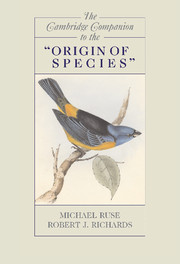Book contents
- Frontmatter
- Foreword
- Introduction
- 1 The Origin of the Origin
- 2 Darwin’s Analogy between Artificial and Natural Selection in the Origin of Species
- 3 Variation and Inheritance
- 4 Darwin’s Theory of Natural Selection and Its Moral Purpose
- 5 Originating Species: Darwin on the Species Problem
- 6 Darwin’s Keystone: The Principle of Divergence
- 7 Darwin’s Difficulties
- 8 Darwin’s Geology and Perspective on the Fossil Record
- 9 Geographical Distribution in the Origin of Species
- 10 Classification in Darwin’s Origin
- 11 Embryology and Morphology
- 12 Darwin’s Botany in the Origin of Species
- 13 The Rhetoric of the Origin of Species
- 14 “Laws impressed on matter by the Creator”? The Origin and the Question of Religion
- 15 Lineal Descendants: The Origin’s Literary Progeny
- 16 The Origin and Political Thought: From Liberalism to Marxism
- 17 The Origin and Philosophy
- 18 The Origin of Species as a Book
- Bibliography
- Index
Introduction
Published online by Cambridge University Press: 28 January 2009
- Frontmatter
- Foreword
- Introduction
- 1 The Origin of the Origin
- 2 Darwin’s Analogy between Artificial and Natural Selection in the Origin of Species
- 3 Variation and Inheritance
- 4 Darwin’s Theory of Natural Selection and Its Moral Purpose
- 5 Originating Species: Darwin on the Species Problem
- 6 Darwin’s Keystone: The Principle of Divergence
- 7 Darwin’s Difficulties
- 8 Darwin’s Geology and Perspective on the Fossil Record
- 9 Geographical Distribution in the Origin of Species
- 10 Classification in Darwin’s Origin
- 11 Embryology and Morphology
- 12 Darwin’s Botany in the Origin of Species
- 13 The Rhetoric of the Origin of Species
- 14 “Laws impressed on matter by the Creator”? The Origin and the Question of Religion
- 15 Lineal Descendants: The Origin’s Literary Progeny
- 16 The Origin and Political Thought: From Liberalism to Marxism
- 17 The Origin and Philosophy
- 18 The Origin of Species as a Book
- Bibliography
- Index
Summary
In 1859, the English naturalist Charles Robert Darwin published his major work, the Origin of Species. In this work, he argued that all organisms living and dead are the end result of a long, slow, natural process of development from forms far simpler and that indeed all life, by reason of its descent from but a few ancestors, is related. He also proposed a mechanism, natural selection, meaning that only a few survive and reproduce and that success in this process is on average a function of the distinctive features of organisms - over time, this leads to change, change that is in the direction of adaptation. Eyes, ears, noses, leaves, trunks, flowers, flippers, fins - these are the things that are produced by evolution, and these are the things crucial for survival and reproduction.
At once, it was recognized that the Origin was a major work of science. Indeed, it was seen as a major event in the history of Western civilization. As Copernicus had expanded space, so Darwin expanded time. Moreover, this was something that impinges on human beings. The Origin is not directly about humans. The only explicit reference is an almost throwaway passage at the end of the book. “Light will be thrown on the origin of man and his history.” But no one was fooled. Humans may be important, but our importance must be tempered by our shared links with the rest of life.
- Type
- Chapter
- Information
- The Cambridge Companion to the 'Origin of Species' , pp. 3 - 13Publisher: Cambridge University PressPrint publication year: 2008



